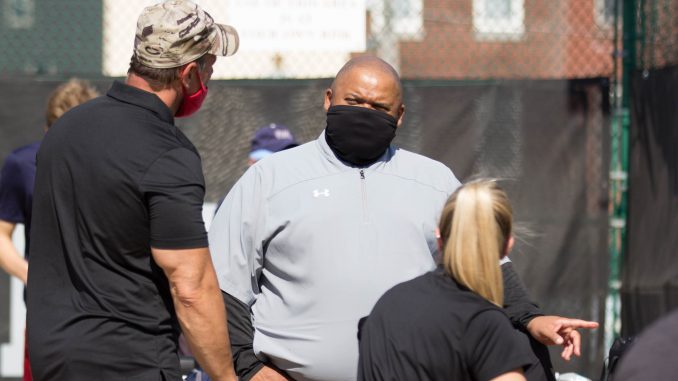
Kevin Addison and his crew are more than athletic trainers this year. They’re educators, communicators and administrators.

Addison, associate director of athletic training at Temple University, and his athletic training staff are responsible for keeping student-athletes healthy during and after practice by administering COVID-19 tests, coordinating trainer availability and preparing student-athletes for travel while educating themselves on COVID-19 regulations for all sports.
Temple’s athletic trainers are managing 12 sports this spring. Addison knew it would be challenging while keeping a safe and healthy environment for all Temple Athletics members with all these teams ongoing, he said.
Originally, The American Athletic Conference came out with a schedule in December 2020 on when competition would take place for each school’s sports team, Addison added.
“I started planning from there on how this season would look, even though 90 percent of the schedules changed,” Addison said. “But by the middle of January, the majority of the schedules were in place, and I started mapping everything out.”
Besides coordinating the athletic trainers’ availability during competitions, Addison and his staff are responsible for making sure the teams could travel safely to other opponents’ schools.
Addison looked into what kind of ventilation systems buses and airplanes had and mask-wearing options for teams. He put together travel kits with wipes and hand sanitizer for the student-athletes to take to away games.
Because there was no competition for Olympic sports in the fall, the athletic trainers only needed to manage six sports then, giving them room for trial and error of implementing new rules to prepare for the spring.
Addison coordinated with trainers on educating student-athletes and coaching staffs on social distancing while on and off the field.
“I did a presentation with all the teams on hygiene as an education piece, this is what we need to be aware of what’s going on,” said Helen Clay Gallagher, associate athletic trainer. “‘This is how you should take care of yourself and take care of others.’”
Gallagher, who manages women’s rowing and volleyball, needs to stay up to date on each sport’s different guidelines from the Centers for Disease Control and Prevention, the NCAA and the City of Philadelphia at the same time, she added.
Student-athletes are not allowed in any athletic facilities until the athletic trainers check their temperature, test them for COVID-19 and complete their daily health survey, Gallagher said.
Athletic trainers give student-athletes a polymerase chain reaction COVID-19 test before each practice, Gallagher added.
If a player tests positive, the athletic trainers have a procedure in place to handle positive cases. Each athletic trainer went through a contact tracing training course to get their certification to be contact tracers, said Kelsie Osato, assistant athletic trainer for women’s lacrosse and cross country.
“There was a different way for how we handle positive cases, how we handle those living on campus versus off campus, which would change the training experience,” Kelsie said.
Athletic trainers separated student-athletes into small groups by household to pinpoint potential positive tests to a specific group of student-athletes, Kelsie added.
Besides implementing COVID-19 protocols, athletic trainers still have to manage treatment for injured players.
“I’m there at practice for protection, but I’m also taking care of a lot of documentation at that time,” Gallagher said. “When they finish their practice, I’ll go through three hours of treatment, then I’ll finish the day with more documents about the treatment I did.”
At the end of the day the student-athletes competing this season are the reason why Addison and his team did everything they could to come up with a way to do that, while keeping everyone safe, he added.
“We had a lot thrown on our plate, but we’ve done everything that was asked of us,” Addison said.


Be the first to comment